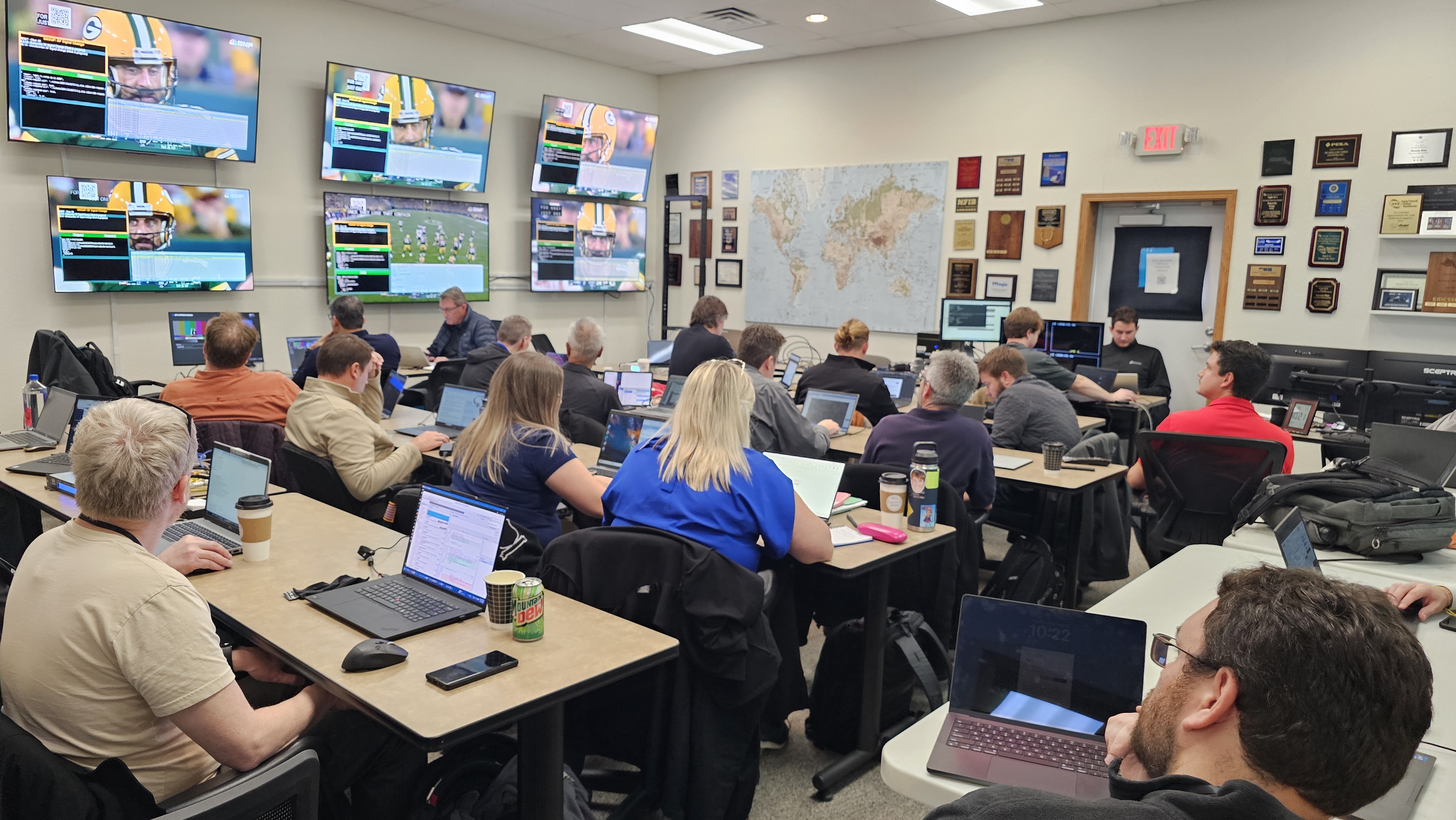ATSC 3.0 Interop Puts NextGen TV Advanced Features In The Crosshairs
A rather exclusive group of 3.0 experts are testing the features to see if they break TVs.

PLYMOUTH, Wisc.—A group of about 20 TV technology vendors supporting NextGen TV are wrapping up their ATSC 3.0 Interop here at Heartland Video Services headquarters after spending the week identifying and resolving any problems implementation of various 3.0 advanced features might create for NextGen TV reception.
“ATSC 3.0 has a lot of knobs that you can turn and tweak to make it whatever you want it to be,” says HVS director of sales Joe Turbolski. “This interop is testing all of those knobs and making sure they all work properly.”
HVS, which has integrated about 90% of all non-Sinclair 3.0 deployments, is hosting the fall test following a similar interop held in the spring at Sinclair’s Hunt Valley, Md., headquarters. Pearl TV and Sinclair/ONE Media are co-sponsoring the gathering.
A Panoply of Tests
At this week’s event, participants are working to ensure that a laundry list of advanced ATSC 3.0 features won’t break consumer NextGen TVs and receiver devices when implemented.

The interop is performing basic service testing for Real-time Object delivery Over Unidirectional Transport (ROUTE) and MPEG Media Transport (MMT) as well as testing: audio accessibility; app-based services; the Run3TV framework; virtual (i.e. Broadcast IP/Broadcast Enhanced Streaming TV) channels; 3.0 translators; Broadcast Positioning System (BPS); datacasting; event stream; dynamic ad insertion; the physical layer; STL Transport Protocol; Enensys cloud redundancy; regional service availability table (RSAT) testing; recovery channel; CBCS digital rights management; and expiring certificates.
In many respects modern TVs in general and NextGen TVs in particular are more similar to a computer than a traditional television, and the room where the interop took place reflects that fact. Seated at rows of tables where the interop is taking place, software engineers focus on the particular 3.0 feature set they traveled to HVS to test.
Six large screen TVs receiving 3.0 OTA signals from three main exciters –one each from GatesAir, Rohde & Schwarz and Teamcast—and test equipment modulators—from Enensys, DekTec and LabMod—display a looping NFL clip, game show clip and other content as programmers run their code and tweak it as needed.
The professional video industry's #1 source for news, trends and product and tech information. Sign up below.
“We have enough test equipment to feed each of those six chains so six different RF channels are on at the same time,” says HVS ATSC 3.0 technologist Mike Schmidt.
In a separate room engineers from Sinclair and HVS were testing BPS as part of the interop. “Sinclair was kind enough to bring their entire BPS kit here so we could do some testing that was very enlightening,” says Schmidt. “The main focus was to make sure that TVs survived BPS being present.”
At the spring interop, BPS testing was confined to simply inserting it into a 3.0 signal. “But here they started to create delays on two paths,” says Schmidt, adding that inserting delays “may in a heavy-handed way” simulate more closely what may happen in practice, especially in a single frequency network (SFN).
“They did delay on one path and everything worked fine,” he says. “Then they did delay on two paths, and it broke some TVs. So, there are still some things that need to be worked out.”
Being There
Notably absent from the event were many consumer electronics companies pursuing the NextGen TV market; however, Schmidt notes that’s to be expected given the timing of the interop. Most CE companies are busy preparing for the 2026 CES Show in early January, he says.
But not having a physical presence isn’t preventing CE companies from benefiting from what the interop uncovers. Their engineers are communicating with those present for the interop in real time via Slack messenger, says Schmidt.
“We have a PCAP [packet capture], or IP data recording, and we make those available at the end of the interop for all of our findings from all of the tests,” he says.
Working from the notes they take from their Slack communications, the CE vendors can then access the PCAP data corresponding to a failure and play it back in their lab, determine whether they can replicate it and then dig in to find a solution, Schmidt adds.
The testing that happens at the interop is important because it focuses the attention of the players trying to advance NextGen TV on making improvements to the implementation of the various features 3.0 offers, he says.
But couldn’t all of these participants do the same thing sitting in their offices scattered across the globe?
“That’s a good question,” says Schmidt. “But human nature factors in. If you’re just off on your own, it’s harder to do and easier to move on to something else.
“If everyone’s concentrated in one place, looking at the same thing at the same time, we can just focus on getting it fixed.”
The interop wraps up today with a half-day session devoted to advancing new technology and looking at new ideas.
Tom has covered the broadcast technology market for the past 25 years, including three years handling member communications for the National Association of Broadcasters followed by a year as editor of Video Technology News and DTV Business executive newsletters for Phillips Publishing. In 1999 he launched digitalbroadcasting.com for internet B2B portal Verticalnet. He is also a charter member of the CTA's Academy of Digital TV Pioneers. Since 2001, he has been editor-in-chief of TV Tech (www.tvtech.com), the leading source of news and information on broadcast and related media technology and is a frequent contributor and moderator to the brand’s Tech Leadership events.

